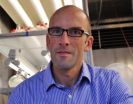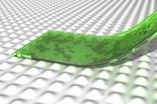(Press-News.org) Bacterial infections usually announce themselves with pain and fever but often can be defeated with antibiotics — and then there are those that are sneaky and hard to beat. Now, scientists have built a new weapon against such pathogens in the form of tiny DNA pyramids. Published in the journal ACS Applied Materials & Interfaces, their study found the nanopyramids can flag bacteria and kill more of them than medicine alone.
David Leong, Jianping Xie and colleagues note that some infectious pathogens can lie in wait, undetectable in the human body or in places that antibiotics have a hard time accessing. Engineered nanomedicine offers a new way to deliver drugs directly into bacterial cells, but the carriers developed so far pose problems such as toxicity. So Leong's team decided to use DNA to build a better, safer drug-delivery tool.
They made little pyramids out of DNA that were so small that thousands could fit in the period at the end of this sentence. Then, they attached gold nanomaterials as fluorescent tags and also packaged the drug actinomycin D (AMD) into the struts of the DNA pyramids. In tests on the common bacteria Escherichia coli and Staphylococcus aureus, the scientists tracked the nanopyramids as they entered the cells and released the drug payload. This killed 65 percent of the S. aureus and 48 percent of the E. coli, compared to 42 percent and 14 percent with AMD alone.
INFORMATION:
The authors acknowledge funding from the Ministry of Education, Singapore.
The American Chemical Society is a nonprofit organization chartered by the U.S. Congress. With more than 161,000 members, ACS is the world's largest scientific society and a global leader in providing access to chemistry-related research through its multiple databases, peer-reviewed journals and scientific conferences. Its main offices are in Washington, D.C., and Columbus, Ohio.
To automatically receive news releases from the American Chemical Society, contact newsroom@acs.org.
Follow us: Twitter Facebook
Tiny DNA pyramids enter bacteria easily -- and deliver a deadly payload
2014-07-09
ELSE PRESS RELEASES FROM THIS DATE:
My brother's keeper
2014-07-09
This news release is available in French.
Montreal, July 9, 2014 — Whether it's how to throw a ball or put together a puzzle, young children learn a lot from their older siblings. While researchers have long known that brothers and sisters teach each other about the world, most of their observations about this have been made in a lab setting.
A new study recently published in the Journal of Cognition and Development by Concordia University education professor Nina Howe takes that investigation a step further by observing how children interact in their natural habitat: ...
What drives a child to abuse alcohol?
2014-07-09
This news release is available in French. By looking at 40 different factors in 14 year old teens, including brain structure and function, personality, life experiences and genetics, researchers can predict with 70% accuracy who will go on to develop binge drinking within the next two years. Impulsivity, hopelessness, sensation-seeking traits, lack of conscientiousness, and other variables such as life events and a family history of drug use contribute to the likelihood of binge drinking. Whether or not the child had had a single drink at age 14 was a particularly ...
One secret of ancient amber revealed
2014-07-09
The warm beauty of amber was captivating and mysterious enough to inspire myths in ancient times, and even today, some of its secrets remain locked inside the fossilized tree resin. But for the first time, scientists have now solved at least one of its puzzles that had perplexed them for decades. Their report on a key aspect of the gemstone's architecture appears in the ACS journal Analytical Chemistry.
Jennifer Poulin and Kate Helwig of the Canadian Conservation Institute point out that much of the amber we see today had its origins millions of years ago, when it exuded ...
Sunshine vitamin ups bowel cancer survival odds, study finds
2014-07-09
Bowel cancer patients with high levels of vitamin D in their blood are more likely to survive the disease, a study shows.
Patients with the highest levels of vitamin D have half the risk of dying compared with those with the lowest levels, the findings reveal.
The study is the first to correlate total blood levels of vitamin D in bowel cancer patients after their diagnosis – which includes that produced after exposure to sunlight and that obtained from dietary sources – with their long term survival prospects.
The University of Edinburgh team tested blood samples ...
Short circuit in the food web
2014-07-09
Jena (Germany) They are amongst the most numerous inhabitants of the sea: tiny haptophytes of the type Emiliania huxleyi. Not visible to the naked eye, when they are in bloom in spring, they form square kilometer sized patches, they are even visible on satellite images. "Together with other phytoplankton, Emiliania huxleyi is responsible for approximately half of the global photosynthesis output," states Prof. Dr. Georg Pohnert of the Friedrich Schiller University Jena (Germany). In the process the greenhouse gas carbon dioxide – CO2 – is extracted from the atmosphere and ...
Fit for the frontline? New study identifies the hearing requirements of British soldiers
2014-07-09
AUDIO:
The gunshot is a binaural recording using KEMAR, the weapon was an SA80 assault rifle and the microphone is 50m downrange from the firer and approximately 30cm from the bullet...
Click here for more information.
University of Southampton researchers, with assistance from the Ministry of Defence, have conducted the first study to identify the hearing requirements of British soldiers fighting on the frontline.
The study, which provides an important and novel insight into ...
Even geckos can lose their grip
2014-07-09
Not even geckos and spiders can sit upside down forever. Nanophysics makes sure of that. Mechanics researchers at Linköping University have demonstrated this in an article just published in Physical Review E. Knowledge that can be of great industrial benefit.
Geckos and spiders that seem to be able to sit still forever, and walk around upside down have fascinated researchers worldwide for many years. We will soon be able to buy smart new fasteners that hold the same way as the gecko's foot. But the fact is, sooner or later the grip is lost, no matter how little force ...
Frogs have developed rapid defences against the red swamp crayfish
2014-07-09
The common frog is one of the amphibians with the highest distribution in the Iberian Peninsula. It reproduces preferably in permanent areas of water where it comes into contact with the red swamp crayfish, which preys on its larvae. Research carried out by the Spaniard Germán Orizaola from the University of Uppsala (Sweden) confirms that the larvae of these frogs have developed a defensive response to the invasive species. They also have deeper tails and larger bodies if they co-exist with the crayfish.
Numerous invasive organisms are currently spreading outside of their ...
RUB chemists develop novel catalyst with 2 functions
2014-07-09
Chemists at the Ruhr-Universität Bochum have made a decisive step towards more cost-efficient regenerative fuel cells and rechargeable metal-air batteries. They developed a new type of catalyst on the basis of carbon, which can facilitate two opposite reactions: electrolysis of water and combustion of hydrogen with oxygen. A catalyst of this kind might make the storage of wind and solar energy and the manufacture of cost-efficient batteries, for example for electric cars, possible. The team published their report in the "International Edition" of the magazine "Angewandte ...
Rotten egg gas holds key to healthcare therapies
2014-07-09
It may smell of flatulence and have a reputation for being highly toxic, but when used in the right tiny dosage, hydrogen sulfide is now being being found to offer potential health benefits in a range of issues, from diabetes to stroke, heart attacks and dementia. A new compound (AP39), designed and made at the University of Exeter, could hold the key to future therapies, by targeting delivery of very small amounts of the substance to the right (or key) places inside cells.
Scientists in Exeter have already found that the compound protects mitochondria – the "powerhouse" ...


